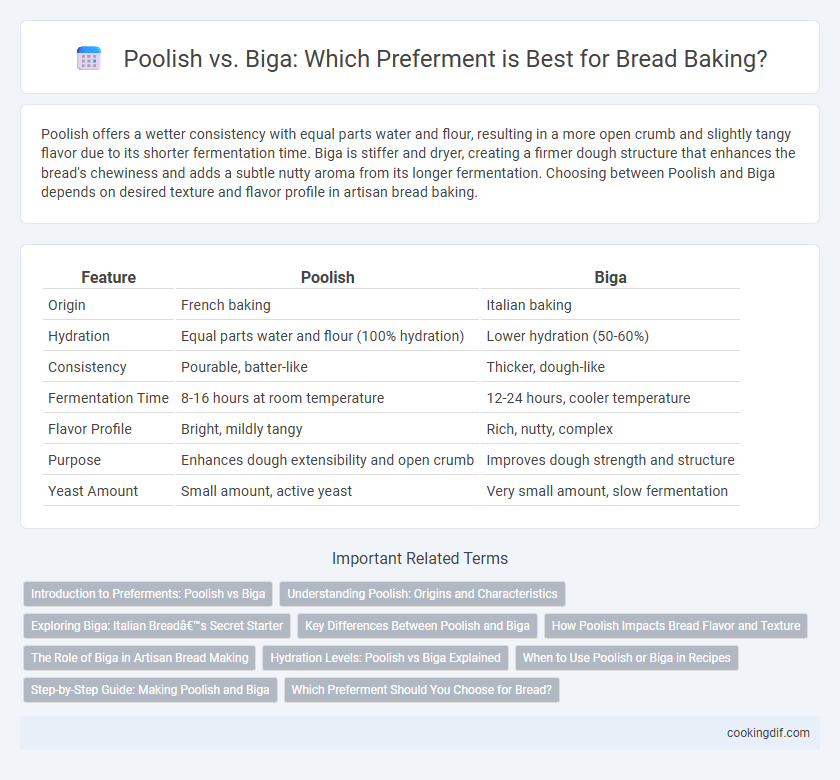Poolish offers a wetter consistency with equal parts water and flour, resulting in a more open crumb and slightly tangy flavor due to its shorter fermentation time. Biga is stiffer and dryer, creating a firmer dough structure that enhances the bread's chewiness and adds a subtle nutty aroma from its longer fermentation. Choosing between Poolish and Biga depends on desired texture and flavor profile in artisan bread baking.
Table of Comparison
| Feature | Poolish | Biga |
|---|---|---|
| Origin | French baking | Italian baking |
| Hydration | Equal parts water and flour (100% hydration) | Lower hydration (50-60%) |
| Consistency | Pourable, batter-like | Thicker, dough-like |
| Fermentation Time | 8-16 hours at room temperature | 12-24 hours, cooler temperature |
| Flavor Profile | Bright, mildly tangy | Rich, nutty, complex |
| Purpose | Enhances dough extensibility and open crumb | Improves dough strength and structure |
| Yeast Amount | Small amount, active yeast | Very small amount, slow fermentation |
Introduction to Preferments: Poolish vs Biga
Poolish and biga are both traditional preferments used to enhance bread flavor and texture, originating from French and Italian baking respectively. Poolish is a wet preferment with equal parts water and flour, producing a sticky, batter-like consistency that promotes a mild tang and open crumb structure. Biga features a drier, dough-like consistency with lower hydration, resulting in a nuttier flavor and firmer crumb in artisanal breads.
Understanding Poolish: Origins and Characteristics
Poolish, a preferment originating from Polish baking traditions and popularized by French bakers, is a wet, sponge-like mixture with equal parts flour and water, typically with a small amount of yeast. Its high hydration level, around 100%, allows for a slightly loose, batter-like consistency, which promotes enzymatic activity and yeast fermentation, resulting in improved dough extensibility and flavor complexity. Poolish enhances crust texture and crumb openness, making it ideal for artisan breads like baguettes and ciabatta.
Exploring Biga: Italian Bread’s Secret Starter
Biga, a traditional Italian preferment, is characterized by its stiff dough consistency and long fermentation time that develops complex flavors and enhances bread texture. Unlike Poolish, which is more liquid and produces lighter, airier bread, Biga contributes a firmer crumb and richer aroma, making it ideal for rustic Italian breads like ciabatta and focaccia. The slow fermentation of Biga also improves the dough's strength and extensibility, resulting in superior volume and crust quality.
Key Differences Between Poolish and Biga
Poolish is a highly hydrated preferment with a 100% hydration ratio, resulting in a batter-like consistency that promotes faster fermentation and produces a lighter crumb structure. Biga, by contrast, has lower hydration, around 50-60%, creating a firmer dough that ferments more slowly and enhances dough strength and flavor complexity. The choice between Poolish and Biga impacts dough handling, fermentation time, and the final bread's texture and taste profile.
How Poolish Impacts Bread Flavor and Texture
Poolish, a wet preferment with equal parts flour and water and a small amount of yeast, enhances bread flavor by allowing extended fermentation that develops complex, tangy notes and a subtle sweetness. Its high hydration level creates a dough that produces an open crumb structure with a light, airy texture and crispy crust. Compared to biga, poolish promotes a moister crumb and more pronounced sourdough-like flavors, making it ideal for artisan-style breads.
The Role of Biga in Artisan Bread Making
Biga, a stiff Italian preferment made from flour, water, and a small amount of yeast, plays a crucial role in artisan bread making by enhancing gluten development and providing a complex, tangy flavor profile. It ferments slowly at a lower hydration level compared to Poolish, resulting in a dough with improved structure and a chewier crumb. Bakers often choose Biga to achieve a robust texture and subtle sourness characteristic of traditional Italian breads like ciabatta and focaccia.
Hydration Levels: Poolish vs Biga Explained
Poolish typically has a high hydration level around 100%, resulting in a wet, batter-like consistency that promotes faster fermentation and enhances dough extensibility. In contrast, biga has a lower hydration level, usually between 50-60%, creating a stiffer dough that ferments more slowly, contributing to a chewier texture and more complex flavor development. Understanding these hydration differences helps bakers choose the preferment that best suits the desired bread crumb structure and taste profile.
When to Use Poolish or Biga in Recipes
Poolish, a loose and highly hydrated preferment, is ideal for recipes requiring a lighter crumb and aromatic complexity, such as baguettes and ciabatta, due to its faster fermentation and tangy flavor profile. Biga, with a stiffer consistency and longer fermentation time, enhances dough structure and chewiness, making it suitable for rustic Italian breads like focaccia and traditional Italian-style loaves. Choosing between poolish and biga depends on the desired bread texture, fermentation time, and hydration level specific to the recipe.
Step-by-Step Guide: Making Poolish and Biga
Poolish is made by mixing equal parts flour and water with a small amount of yeast, then fermenting at room temperature for 12 to 16 hours until bubbly and aromatic. Biga requires mixing flour, a smaller amount of water compared to poolish, and a tiny yeast quantity, fermenting for 16 to 24 hours to develop a drier and denser texture. Both preferments enhance dough flavor and texture but differ in hydration and fermentation time, affecting bread crumb structure and complexity.
Which Preferment Should You Choose for Bread?
Poolish and biga are two popular preferments used in artisan bread baking, each providing unique flavors and textures. Poolish, a wet preferment made with equal parts flour and water, promotes extensibility and open crumb, ideal for softer, airier loaves like baguettes. Biga, a stiffer preferment with lower hydration, enhances dough strength and imparts a nutty, slightly tangy flavor, perfect for rustic Italian bread with a chewy crust.
Poolish vs Biga for preferment Infographic

 cookingdif.com
cookingdif.com